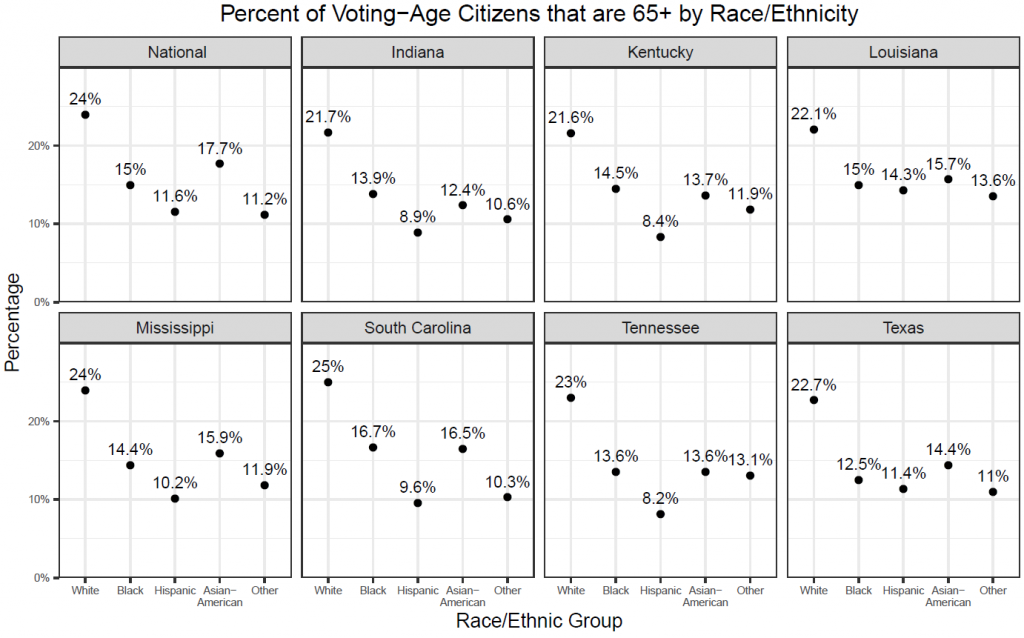The following is a guest post from Chris Warshaw, a political scientist at George Washington University:
On November 3, 2020, voters across the country will go to the polls to cast their ballots for President, among other local, state, and federal offices. In thirty-four states and the District of Columbia, they will—if they choose to—be able to vote by mail without providing any excuse for needing to do so. In nine states, they will only be able to vote by mail if they are able to provide a valid excuse for needing to vote by mail.[1] And in seven states—Indiana, Kentucky, Louisiana, Mississippi, South Carolina, Tennessee, and Texas—older voters are permitted to vote by mail without an excuse, while all other voters must provide an excuse to do so.[2]
In Texas, that latter category of access to vote by mail was recently challenged as violating the Twenty-Sixth Amendment, which states that “The right of citizens of the United States, who are eighteen years of age or older, to vote shall not be denied or abridged by the United States or by any State on account of age.” This case will soon be heard in the Fifth Circuit, and possibly, the United States Supreme Court as well.
Whether or not it is constitutional to provide more or fewer voting options to voters based on their age, the demographic implications of providing no-excuse mail voting to only older voters extend beyond preferencing just a voter’s age. It also has differential effects across racial and ethnic groups. White Americans tend to be much older than members of other racial and ethnic groups. Across the nation, about 24% of Whites are 65 or older, while only 15% of Blacks and 12% of Hispanics are senior citizens.[3] This means that older Americans are much whiter than the general population. Non-Hispanic Whites constitute about 68.5% of the nation’s citizen voting age population. But over 79% of senior citizens are White.

These racial disparities are magnified in the six states where only older citizens are allowed to cast no-excuse absentee ballots.[4] In Texas, for example, non-Hispanic Whites are about twice as likely to be 65 or older as Blacks or Hispanics. In South Carolina, Whites are over 2.5 times more likely be senior citizens than Hispanics. In Tennessee, Whites are nearly three times more likely to be over 65 as Hispanics. More detailed state-level data on racial disparities between all voting age citizens and older citizens are here.
The racial disparities across age groups mean that voting rules which make it easier for senior citizens to vote than younger Americans inevitably advantage White voters relative to Blacks, Hispanics, and other racial groups. This means that elections in Indiana, Louisiana, Mississippi, South Carolina, Tennessee, and Texas are inherently biased against racial minorities. This could mean that these rules fall afoul of the Voting Rights Act. At a broader level, these rules harm democratic representation. They are probably skewing election outcomes in these states, and possibly downstream policy outcomes as well, in favor of the preferences of Whites. These racial biases are likely to be magnified in 2020 because many voters may be deterred from voting-in-person due to fears of being infected with Covid-19.
[1] Those states are Alabama, Arkansas, Connecticut, Delaware, Massachusetts, Missouri, New Hampshire, New York, and West Virginia. See https://www.vote.org/absentee-voting-rules/.
[2] See id; see also https://slate.com/news-and-politics/2020/04/26th-amendment-texas-absentee-ballots.html.
[3] I used the 2014-2018 5-year sample of the American Community Survey to analyze the age distribution of voting age citizens across racial groups.
[4] Under Kentucky law, a voter may vote by mail if “on account of age, disability or illness, [the voter] is not able to appear at the polls on election day may vote by a mail-in absentee ballot.” See Kentucky Revised Statutes § 117.075(1). Because the statute does not explicitly provide an age floor for qualifying for a mail-in ballot, I used age 65 in the chart for Kentucky for illustrative purposes.